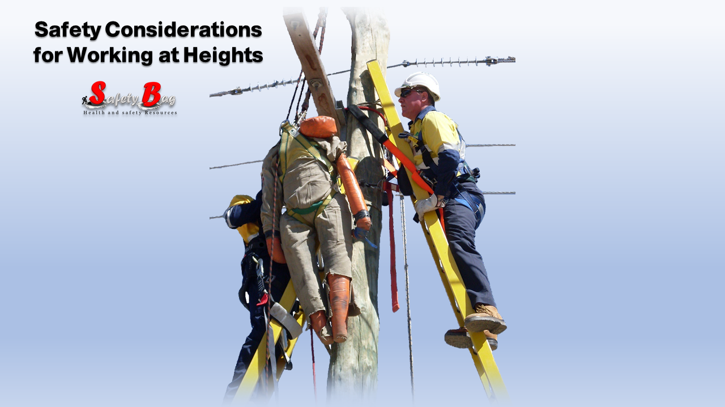Falls cause more deaths in construction than any other hazard. In 2011, falls accounted
for over a third of the 721 total construction deaths. Workers performing tasks 6 feet or
more above lower levels are at risk of fatal falls or serious injuries.
This training guide will help you plan how to prevent injuries and fatalities from falls
among your crew, and provide training to your workers. It includes the following tools:
- Instructions for using the Toolbox Talks to train workers in fall prevention (pages 2–3).
- A series of Toolbox Talks about various fall prevention topics (pages 5–12).
Additional resources:
- A Fact Sheet, in English and Spanish, with some key information about preventing falls (page 15).
- A Wallet Card, in English and Spanish, which provides the web address for OSHA’s Fall Prevention Campaign website and OSHA’s contact information (page 16).
- Easy-to-read OSHA posters, in English and Spanish, for the worksite and the community that you can copy and distribute to workers (page 17).
- A bilingual booklet on ladder safety, Falling Off Ladders Can Kill: Use Them Safely, can be read on any mobile device (page 18).
The training is designed to be:
- Short — Each Toolbox Talk should last approximately 5-10 minutes. Although some talks contain more material than others, Toolbox Talks can be given at meetings before the work shift or during breaks.
- Participatory — Workers attending the talk should be able to ask questions and discuss the topic. This increases the likelihood they will remember the information.
- Easy to follow.
Read the OSHA Fall Protection Toolbox Talks and Trainer Guide by Flipping the File below :
Why is it important to prevent falls?
- Preventing falls can mean the difference between life and death. Hundreds of workers die from falls each year. You can prevent such deaths by planning to get the job done safely, providing the right fall protection equipment, and training all workers to use the equipment safely.
- Many construction workers perform tasks at a height that requires protection from fall hazards.
- Having a serious injury or death occur at work affects everyone at a worksite.
- A fall can occur in a split second without any time for the worker to react.
Also Read: Stairways as a fall prevention measure
Carrying out the training
Short and direct Toolbox Talks can be a very efficient way to reach workers with health and safety information. Like all training, delivering the information effectively takes preparation and a desire to involve the workers in health and safety at the workplace. Employers may train workers to lead the training or have supervisors provide the training. Studies have shown peer-to-peer training is effective, participatory, and well-retained.
In this guide, you will find advice for trainers that will encourage discussion and enable workers to actively participate in keeping the job site safe.
Follow these three steps to prepare and present a Toolbox Talk:
- Read and become familiar with the next section, “How to use Toolbox Talks.”
- Give one of the Toolbox Talks.
- Get feedback from the other workers. Did they understand the material? Was it well presented? How could the training be more relevant to their work?
How to use Toolbox Talks
The training guide is written so that you can easily follow it. The training is divided into
three Toolbox Talks, each addressing a fall prevention topic. These include:
- First Talk: Ladder Safety
- Second Talk: Scaffolding Safety
- Third Talk: Roofing Work Safety
To provide this training, you will be leading a discussion in which you give an example
of a fatality related to the topic, discuss how it could have been prevented, ask questions,
and encourage participation.
How Toolbox Talks are formatted
- Each Toolbox Talk begins with an example of the types of incidents that are possible if workers do not follow the fall prevention guidelines outlined in the training.
- Following the job site example, the Toolbox Talk lists guidelines for preventing falls related to the topic (e.g., ladders).
- Finally, each training sheet includes blank lines for workers to include ways that the topic is applicable to their job site.
Read: Tool Box Talk: Hand Grinder Safety
Preparing to teach the training sessions
- Spend about 15 minutes to become familiar with the Toolbox Talk.
- Print a copy of a relevant Toolbox Talk and think about how the topic relates to your
specific worksite. - Look through the educational materials and resources listed at the end of the training
guide, along with other materials on OSHA’s website, to find materials to supplement
the Toolbox Talk.
Advice for trainers
Safety meetings work best if the whole crew actively participates. This makes it more
interesting and more likely that people will remember the information you’ve given
them. Here are some ways to encourage everyone to get involved:
- Ask questions instead of simply giving them the information. After you ask a question, wait a short time to let people think. Then, call on volunteers to answer.
- Ask about personal experience. This can help the group see how the topic is relevant to them. You could ask: Has anyone here fallen off a ladder? What happened?
- Make sure everyone has a chance to talk. If a crew member is talking too much, invite someone else to speak.
- Never make fun of anyone or put anyone down, especially for asking questions.
- Don’t fake it. If you don’t know the answer to a question, don’t guess. Write the question down and promise to get back to them.
- Stick to the topic. If the crew’s questions and comments move too far from the topic, tell them that their concerns can be addressed later, either privately or in a future safety meeting.
Download The Book
OSHA Fall Protection Toolbox Talks and Trainer Guide
More Downloads
- Books: How to Plan for Workplace Emergencies and Evacuation
- Books: Firefighting Precautions at Facilities with Combustible Dust
- Books: A Guide to Electrical Safety
- Books: Preventing Falls in Scaffolding Operations
- Handbook: Worker’s Safety
- Books: A Guide to Safety in Confined Spaces
- Books: OSHA-Hazard communication for small Entity
- Books: OSHA-Permit Required Confined Spaces
- OSHA: Underground Construction (Tunneling)
- OSHA Recommended Practice of Health and Safety programs in construction
- Books: OSHA-Is it Safe to Enter Confined Space?
- Books: General Industry Digest
- Books: A Guide to Bloodborne Pathogens in the workplace
- Books: 5-Minute Workplace Safety Talks
- CAL/OSHA Scaffold Guide for safe use of supported Scaffolds
- Books: CAL/OSHA Pocket Guide for Construction Industry
- Books: Let’s Talk Safety
- Books: OSHA Fall Protection Toolbox Talks and Trainer Guide
- Tool Box Talk: Don’t Let Chemicals Get to You
- Tool Box Talk: Hand Grinder Safety
- Tool Box Talk: Lockout and Tagging
- Tool Box Talk: Winter Driving Safety Tips
- Tool Box Talk: Working Around Heavy Equipment
- Tool Box Talk: Rotary Hammers-Hammer Drills
- Tool Box Talk: Carbon Monoxide Poisoning
- Tool Box Talk: Boom Truck Safety
- Tool Box Talk: Biohazard Safety




